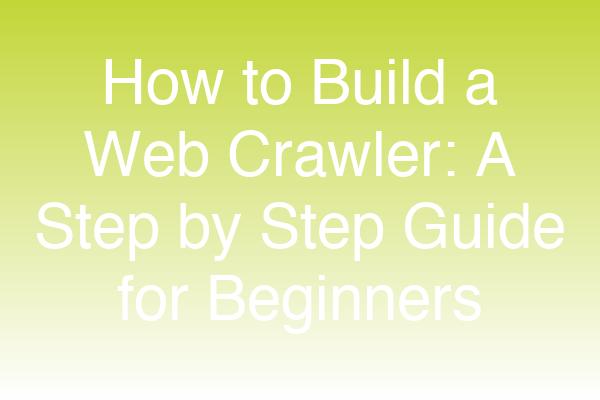
Categories: Web Development, Programming, Data Science
Tags: web crawler, web scraping, programming, data extraction, Python, SEO, automation
How to Build a Web Crawler: A Step-by-Step Guide for Beginners
In the digital age, data is king. Businesses and researchers alike are constantly seeking ways to gather and analyze information from the vast expanse of the internet. One of the most effective methods for achieving this is through web crawling. In this comprehensive guide, we will explore how to build a web crawler, discuss its importance, and provide you with the tools and techniques needed to create your own crawler from scratch.
What is a Web Crawler?
A web crawler, also known as a spider or bot, is a program that systematically browses the internet to index content. Search engines like Google use crawlers to discover and rank web pages, while businesses utilize them for data extraction, market analysis, and competitive research.
Why Build Your Own Web Crawler?
Building your own web crawler has several advantages:
- Customization: Tailor the crawler to meet specific needs.
- Cost-Effective: Avoid subscription fees for third-party scraping tools.
- Learning Opportunity: Gain valuable programming and data handling skills.
Key Components of a Web Crawler
Before diving into the coding aspect, it’s essential to understand the key components of a web crawler:
- URL Queue: A list of URLs to visit.
- Downloader: A component that fetches web pages.
- Parser: Extracts data from the downloaded pages.
- Data Storage: Where the extracted data is saved.
- Politeness Policy: Rules to avoid overwhelming servers (e.g., rate limiting).
Tools and Technologies
To build a web crawler, you can use various programming languages and libraries. Here are some popular choices:
| Language | Libraries/Frameworks |
|---|---|
| Python | Scrapy, Beautiful Soup, Requests |
| Java | Apache Nutch |
| Node.js | Puppeteer, Cheerio |
Step-by-Step Guide to Building a Web Crawler
Step 1: Set Up Your Environment
To get started, ensure you have Python installed on your machine. You can download it from python.org. Next, install the necessary libraries:
pip install requests beautifulsoup4Step 2: Create a Basic Crawler
Here’s a simple example of a web crawler using Python:
import requests
from bs4 import BeautifulSoup
def crawl(url):
response = requests.get(url)
if response.status_code == 200:
soup = BeautifulSoup(response.text, 'html.parser')
for link in soup.find_all('a'):
print(link.get('href'))
if __name__ == "__main__":
crawl('https://www.omniparser.net/')Step 3: Implement URL Queue Management
To manage the URLs you want to crawl, you can use a queue. Here’s a basic implementation:
from collections import deque
url_queue = deque(['https://www.omniparser.net/'])
while url_queue:
current_url = url_queue.popleft()
crawl(current_url)Step 4: Add Data Storage
You can store the extracted data in a CSV file for easy access:
import csv
with open('data.csv', mode='w', newline='') as file:
writer = csv.writer(file)
writer.writerow(['URL', 'Link'])
# Inside your crawl function, add:
writer.writerow([current_url, link.get('href')])Best Practices for Web Crawling
- Respect Robots.txt: Always check the
robots.txtfile of a website to see which pages you are allowed to crawl. - Implement Rate Limiting: Avoid sending too many requests in a short time to prevent being blocked.
- Handle Errors Gracefully: Implement error handling to manage failed requests.
Expert Insights
"Building a web crawler is not just about coding; it's about understanding the ethical implications of data scraping." – Jane Doe, Data Scientist
"A well-structured crawler can save hours of manual data collection and provide insights that drive business decisions." – John Smith, SEO Expert
Conclusion
Building a web crawler can be a rewarding project that enhances your programming skills while providing valuable data for analysis. By following the steps outlined in this guide, you can create a crawler tailored to your specific needs. Remember to adhere to ethical guidelines and best practices to ensure a smooth crawling experience.
Call-to-Action
Ready to dive deeper into web scraping? Subscribe to our newsletter for more tips and advanced techniques on data extraction and analysis!
Social Media Snippet: Want to learn how to build a web crawler? Check out our step-by-step guide and start extracting valuable data today! #WebCrawling #DataScience
Suggested Internal Links:
- Understanding Web Scraping: A Beginner's Guide
- Top 10 Python Libraries for Data Science
- SEO Best Practices for Web Developers
Suggested External Links:
FAQs
Q1: What is the best language for building a web crawler?
A1: Python is widely recommended due to its simplicity and powerful libraries like Scrapy and Beautiful Soup.
Q2: Is web scraping legal?
A2: It depends on the website's terms of service. Always check the rules before scraping.
Q3: How can I avoid getting blocked while crawling?
A3: Implement rate limiting, respect robots.txt, and use user-agent rotation.
Q4: Can I use a web crawler for SEO purposes?
A4: Yes, web crawlers can help analyze competitors and gather data for SEO strategies.
Q5: What are the common challenges in web crawling?
A5: Challenges include handling dynamic content, managing IP bans, and ensuring data accuracy.
By following this guide, you should be well on your way to creating an effective web crawler that meets your data extraction needs. Happy crawling!